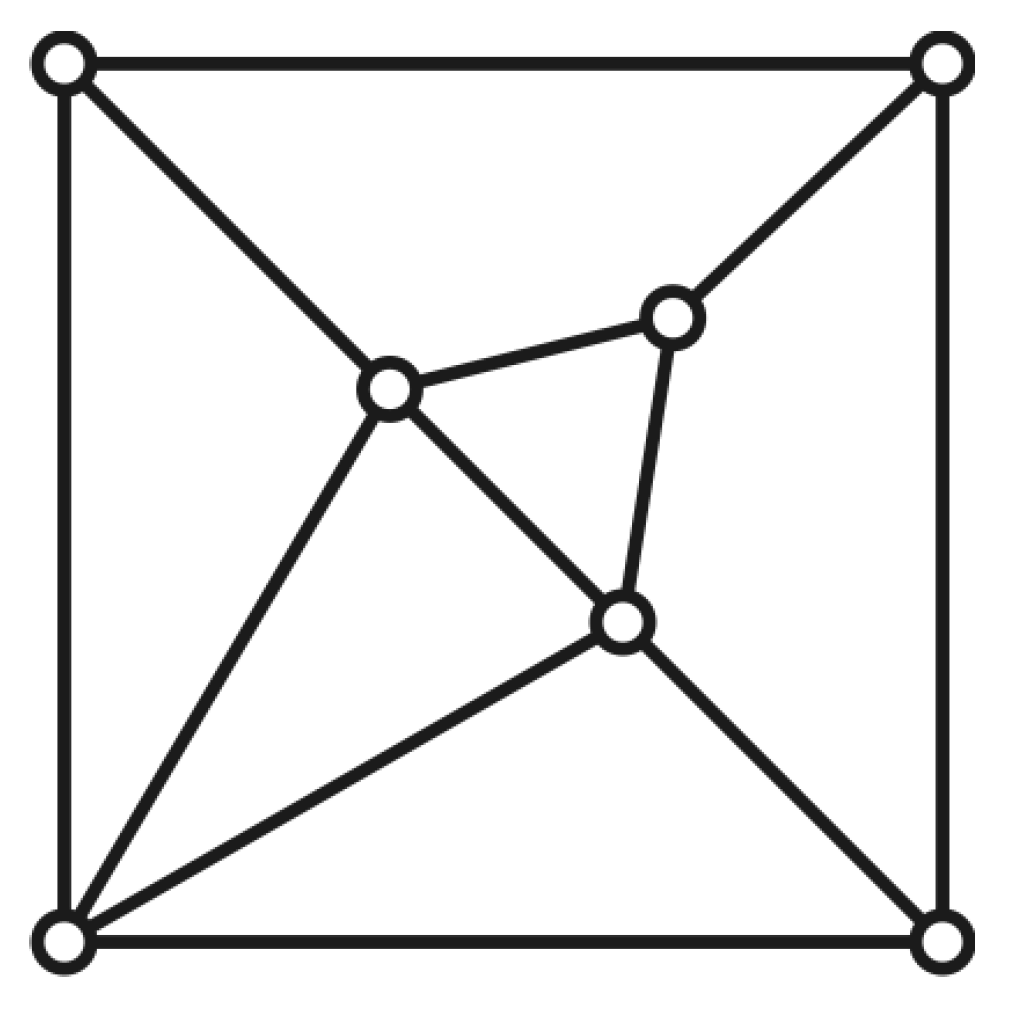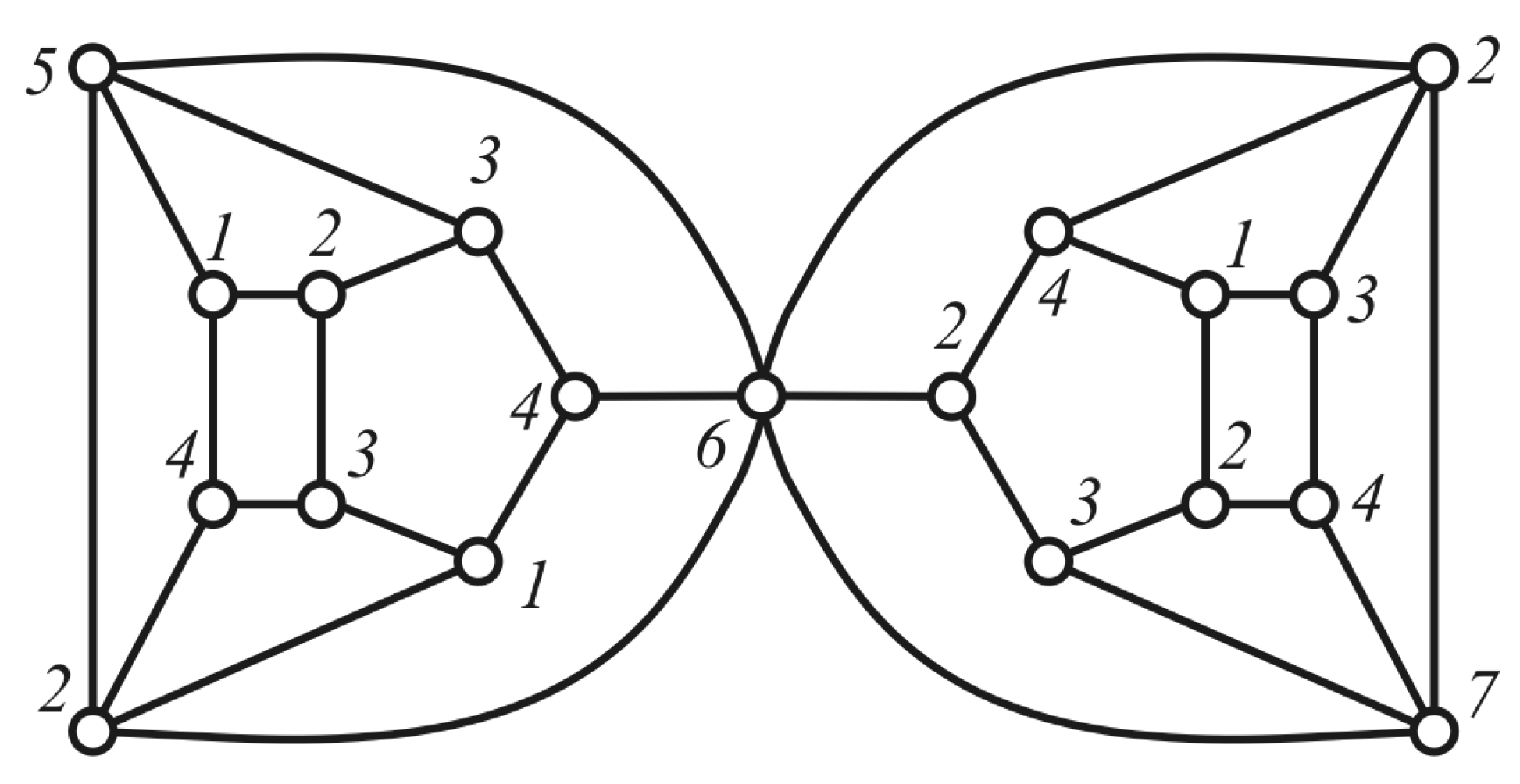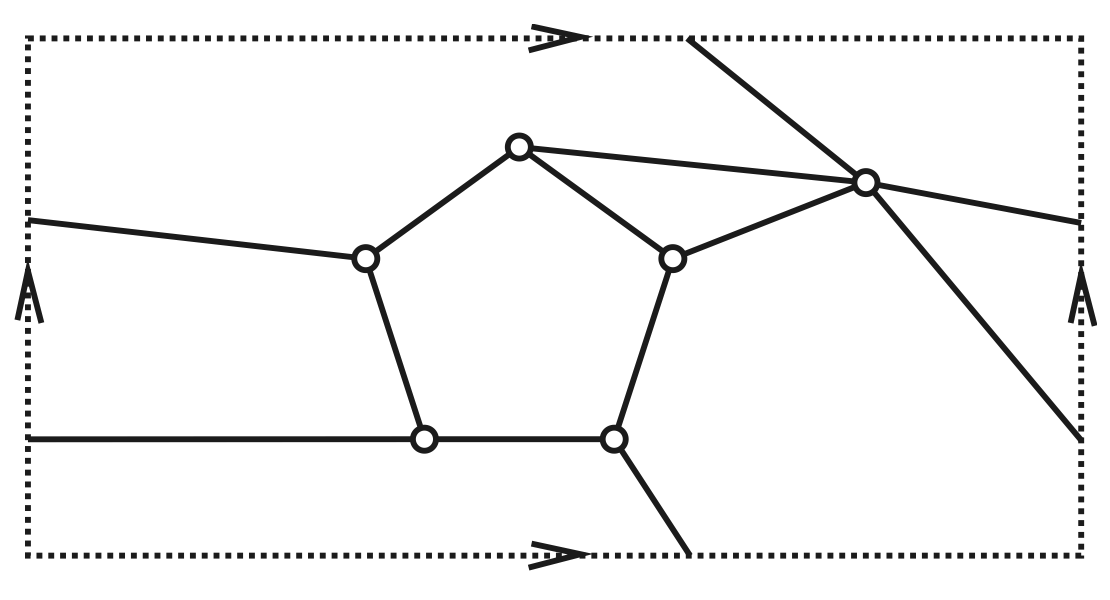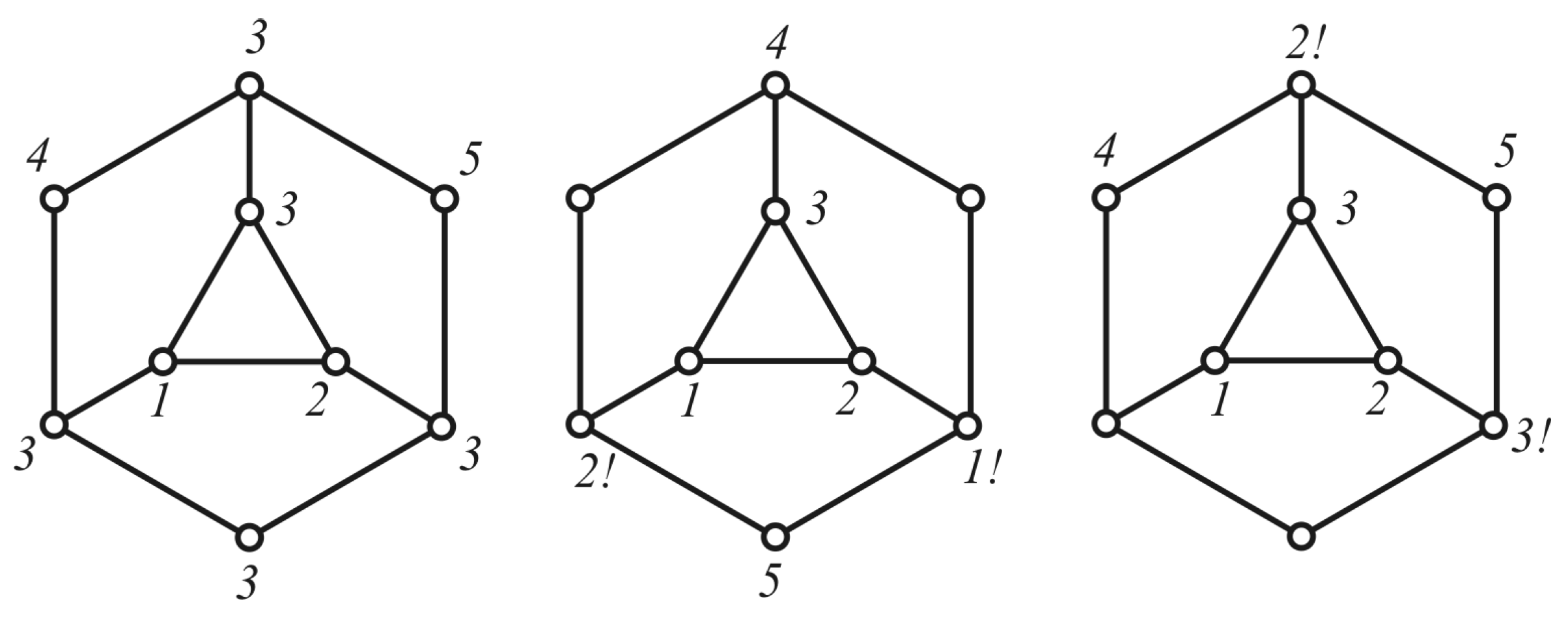1. Introduction
Throughout this paper, we consider simple connected plane graphs (that is, graphs drawn in the plane such that no two edges cross). The faces of a plane graph G (that is, connected regions of ∖G) will be here represented in graph-theoretic sense by closed walks: the boundary walk of a face of G is a closed walk whose vertices and edges are incident with and, for each , is followed by (indices modulo k) in the clockwise order of edges around in G. The boundary walk associated with unbounded region of ∖G is the outerface of G; G is called outerplanar if its outerface contains all vertices. A k-colouring of a graph is a mapping ; if, for every edge , holds, c is called proper.
Within years of graph theory research, constant attention was paid to vertex or edge colourings of plane graphs defined by constraints on the faces—among the earliest examples, one can mention cyclic colourings introduced by Ore and Plummer [
1] (where the vertices of each face are coloured differently. The corresponding chromatic invariant is the cyclic chromatic number
; for the obtained results, see the survey [
2]). Many variants of facial colourings are discussed in recent surveys [
3,
4]. Here, we turn our attention to a kind of facial colouring inspired by recent notion of homogeneous colouring from [
5]:
A facial
ℓ-homogeneous colouring of a plane graph
G is a proper vertex colouring of
G such that each face of
G has
ℓ colours on its boundary (thus, from the point of view of colour spaces of faces, such a colouring shows a kind of global symmetry feature); if
G admits such a colouring, it is called facially
ℓ-homogeneous. The set of those positive integers
ℓ for which there exists a facial
ℓ-homogeneous colouring of
G is the palette of facial homogeneity of
G,
. For fixed
, the scale of facial
ℓ-homogeneity of
G (denoted by
) is defined as the set of all positive integers
k for which there exists a facial
ℓ-homogeneous proper vertex
k-colouring of
G. For graph
G with a facial
ℓ-homogeneous colouring, we assign
Observe that plane triangulations and plane bipartite graphs are trivially facial homogeneously colourable. In general, for a plane graph
G with faces of the same size
,
and
(as facial
-homogeneous colouring of
G is simply its cyclic colouring); in addition,
forms an integer interval (as one may modify an existing facial homogeneous
k-colouring,
, by assigning the colour
a vertex previously coloured with a non-unique colour). Furthermore, a facial
ℓ-homogeneous colouring of
G that satisfies
is proper polychromatic colouring, investigated in [
6] (relaxing the condition on colouring to be proper). In that paper, it was proved that the problem of polychromatic three-colourability (not necessarily proper) of plane graphs is NP-complete even for graphs with faces of sizes three and four only. On the other hand, Hoffmann and Kriegel proved in [
7] that every two-connected plane bipartite graph admits a proper polychromatic three-colouring, and its existence was shown also for subcubic plane graphs different from
and
with one edge subdivided, see [
8]. In [
9], it was proved that every cubic bipartite plane graph has a polychromatic proper four-colouring. Note that a plane graph which has no proper
ℓ-polychromatic colouring may still possess a facial
ℓ-homogeneous colouring using more than
ℓ colours; actually, all graphs mentioned in
Section 2 are facially 3-homogeneous. In this section, we also address other questions connected with facially homogeneous colourings as well as computer assisted approaches to facial homogeneity testing.
Section 3 contains several sufficient conditions for plane graphs to be facially 3-homogeneous. Finally, in
Section 4, we discuss facial homogeneous colourability of graphs embedded into higher surfaces, providing some examples of embeddings which are not colourable in this manner.
2. Computational Results
In our study of facial homogeneous colourings, we tested several large collections of plane graphs to obtain partial answers to the following questions:
Does there exist a plane graph G with ?
For , what is the difference ?
Does there exist a plane graph G for which is not an integer interval?
Does there exist a plane graph G with some such that is not an integer interval?
For testing, several approaches may be considered. The one we used is based on the existing Wolfram Function Repository procedure
FindProperColorings[G,k] (see [
10]) which returns, for an input planar graph
G and a positive integer
k, the list of all proper
k-colourings; taking a vertex colouring from the obtained list, it was then tested for the condition of facial homogeneity (a particular list of faces of a plane drawing of
G can be obtained using the procedure
IGFaces[G] from the IGraphM package, see [
11]). Note that a planar graph of vertex connectivity one or two may have several different plane embeddings, of which
IGFaces finds just one. Thus, for such graphs, nonequivalent plane embeddings with different nature of facial homogeneous colourability may exist. The smallest such example is the five-vertex graph obtained from a four-star by adding an extra edge: its plane embedding with two faces of size five is both facially 3- and 4-homogeneous, whereas the embedding with one triangular face and another one of size seven is not facially 4-homogeneous. On the other hand, polyhedral graphs—that is, planar and three-connected—have unique plane embedding.
Another approach which may come under consideration involves the integer linear programming formulation of the facial homogeneous colourability problem: for a plane graph with and two positive integers , does there exist a facial ℓ-homogeneous proper colouring of G which uses colours ? We introduce, for every , a binary variable which equals one if the colour i was used in colouring of G (the objective function to be minimized is then ), and, for , a binary variable indicating whether the vertex was coloured with colour i. Furthermore, we consider several constraints:
- -
For each , (the vertex is coloured with only one colour);
- -
For each and for each , (the colour i is not used on both endvertices —the properness condition);
- -
For each and each , (if is coloured with colour i, this colour is marked as used);
- -
For each and for each , consider the constraint set consisting of;
- -
(each of ℓ colours is used on the face f);
- -
For each , (except for colours , no other colour is used on f);
Now, a face is ℓ-homogeneously colourable if and only if there exist for which all constraints in are satisfied.
(Note that, for polychromatic colouring, there is only one constraint set for each face f of G).
The detailed results on numbers of small graphs having particular values
of are contained in
Table 1 and
Table 2.
Table 1 contains the results on facial 3-homogeneity of polyhedral graphs up to 10 vertices.
Table 2 contains the results on facial 4-homogeneity of non-bipartite cubic polyhedral graphs of girth of at least 4 up to 20 vertices (since these graphs are not considered in [
9]).
These tests showed that, among all polyhedral graphs up to 10 vertices, only two (see
Figure 1) have empty palettes of facial homogeneity:
Theorem 1. The graph does not admit a facial homogeneous colouring.
Proof. Note first that is three-colourable, but not in polychromatic way (considering the cycle , it has to contain unique colour—say, three—but not on e, a or g, as d would be uncolourable or or would bear only two colours, respectively. If three is used on b, then it must appear also on j and f, but then or would bear two colours; the similar argument holds also if three is used on i). Assume that there exists a facial 3-homogeneous colouring of using at least four colours, with three colours one, two and three on the outerface. Up to the symmetry, there are just two possibilities for the colour four: either it is used on d (then must have the same colour as well as ), or on e (then must have the same colour and must also have the same colour, forcing b to have the same colour as i and j); both lead to a contradiction. □
Theorem 2. The graph does not admit a facial homogeneous colouring.
Proof. It is easy to check that and, in addition, none of its proper three-colourings are facially 3-homogeneous (colouring the vertices by one, two, three, respectively, two vertices on the face have the same colour. Without loss of generality, let i has colour two; then j has to be coloured by three and both by one, yielding that also c has colour one—but then one of the faces bears only two colours, a contradiction). Assume that there exists a facial 3-homogeneous colouring of using at least four colours, with three colours one, two and three on the outerface. Then, by symmetry, we have three possibilities for the appearance of the colourfour:
- -
c has colour four. Then cannot be coloured by four, hence e has the same colour as a and b, a contradiction.
- -
e has colour four. Let have colours one and two, respectively. Then c must have colour three and, subsequently, d and f have colour three. As cannot have colour four, both are coloured by three, a contradiction.
- -
h has colour four. Now, if c has colour at least four, then e must have the same colour as a and b, which is impossible. Thus c has colour three. Then both must have the same colour as well as , a contradiction.
□
It is interesting that, for majority of non-bipartite graphs of the mentioned collections,
; notable exceptions include wheels
, the graph on
Figure 2 or odd prisms. The smallest graph
G for which
is the graph
(of four-sided pyramid) without one spoke edge. Moreover, we found just few graphs with
, and only one of them has
, see
Figure 3.
That this graph has no polychromatic three-colouring is easy to see: a and j would have the same colour, say one, yielding that would be also coloured by one, but then at least two quadrangular faces bear two colours, a contradiction. Assume further that there exists its facial 3-homogeneous colouring using four colours, with three colours one, two and three on the outerface. Up to the symmetry, there are just two possibilities for the colour four: either it is used on d (then must have the same colour as e, which is impossible), or on e. If have colours one and two, respectively, then must have the same colour, namely, three. The vertex f then has one of colours one or two—according to the symmetry, we may consider it has colour one—and do not have colour three. Hence g must have colour three, implying that one of faces bears just two colours, a contradiction.
3. Sufficient Conditions for Facial Homogeneity
In this section, we present here several sufficient conditions which guarantee facial homogeneous colourability of plane graphs (concentrating mainly on facial three-homogeneity). Note first that the relation between facial homogeneous colourings of graph blocks and the graph itself is only one-way.
Lemma 1. Let G be a plane graph consisting of blocks . If each is facially ℓ-homogeneous, then G is also facially ℓ-homogeneous.
Proof. By induction on r, the number of blocks. Since the claim trivially holds for , we assume . Then, among blocks of G, there is a block—say, —which contains exactly one cut-vertex x. Let be the outerface of and be the face of G different from faces of which contains, as a boundary subwalk, the boundary of . By assumption and the induction, both and the graph are facially ℓ-homogeneous. Then, it is possible merge facial ℓ-homogeneous colourings of these two graphs to a joint facial ℓ-homogeneous colouring of G by choosing a permutation of colours in a facial ℓ-homogeneous colouring of such that and contain the same ℓ colours and the colour of x in is the same as in . □
The converse of this lemma, however, is not true: see the facially 4-homogeneous graph on
Figure 4 whose both blocks do not admit facially 4-homogeneous colouring.
Theorem 3. Let G be a connected plane graph with a girth of at least 6. Then G has the facial 3-homogeneous colouring and .
Proof. By induction on the number of vertices of G. Note first that, from Euler’s formula (where are the numbers of vertices, edges and faces of G, respectively), we obtain . According to the girth assumption, for every face and so the first sum is nonnegative but then the negativity of the right-hand side of the sum-equation implies the existence of vertices of degrees less than three, thus . Furthermore, without loss of generality, we may assume that (a vertex x of degree one can be easily coloured by one of three colours on that face of which is incident with the pendant edge ) and that G is not a cycle.
Let , , be a trail of G such that are of degree 2 and are of degree , and let . Consider first the case when . Then, by girth assumption, ; in addition, P is a cycle and x is a cut-vertex of G. The graph is a plane graph of girth at least six which is smaller than G, thus, it has facial three-homogeneous colouring using at most four colours. Let be a face of which is incident to x and let and be facial subwalks of such that their union is the boundary of , lies in the interior of P and in the exterior of P. If P bounds a face in G, then or is empty; otherwise, the walks and are boundary walks of two distinct faces of G. Anyway, since , the vertices in G can be regularly coloured using all three colours used on in . Thus the cycle P uses three colours and, subsequently, each face of G which has P as a part of its boundary, uses three colours as well.
Hence, we can assume that P is a path. Now, if is not connected, then it has two components and where , ; let be faces of and incident with x and y, respectively, which resulted from the face of G which contained P. Then are plane graphs of girth of at least six which are smaller than G, hence both have facial 3-homogeneous colouring using at most four colours. In addition, it is possible to choose colours in in such way that three colours on are the same as three colours used on . Then it is easy to colour vertices in G using three colours of in a way that the colouring of G obtained from colourings of is facially 3-homogeneous.
If is connected, then the path P belongs to two faces of G and its deletion results in a face with boundary walk of . is a plane graph of girth of at least six; hence, it has facial 3-homogeneous four-colouring with, say, colours one, two and three on .
If , then, regardless of colours of in , it is always possible to colour vertices with colours from such that P uses all three colours ; this yields the desired facial three-homogeneous colouring of G.
Finally, let . With respect to symmetry, we discuss three possibilities how to extend facial three-homogeneous colouring of to G:
- 1:
In a facial three-homogeneous colouring of , both subwalks , use all three colours one, two, three. Then can be coloured with colour from which is different from colours of .
- 2:
The subwalk uses only colours oe and two while uses all three colours one, two and three. Then can be coloured with colour three.
- 3:
The subwalk uses only colours one, two, and uses only colours one, three; hence are coloured with colour one. Then can be coloured with colour four.
□
Theorem 4. Let G be a plane graph with girth . Then G has the facial three-homogeneous colouring and .
Proof. The proof runs in the same way as the proof of the previous theorem, with the following modification: by [
12], it is known that plane graphs with girth
contain two neighbouring vertices of degree two; thus, after the reduction in the path
with inner vertices of degree two it always holds that
, so three last cases of previous discussion can be omitted. □
Note that the results of [
6] (Theorem 2) imply that each plane graph of girth of at least six has a polychromatic three-colouring; however, it need not be necessarily proper.
We leave, as an open problem, the question whether there exists a plane graph G of girth at least six for which . We also believe that, for facial three-homogeneity, the bound on the girth in Theorem 1 can be decreased to five.
The following theorem extends the results of [
6] (Proposition 7) on polychromatic three-colourability of outerplane graphs:
Theorem 5. Let G be a subdivision of an outerplane graph. Then G has the facial three-homogeneous colouring and .
Proof. By induction on number of vertices of G. Since G is a subdivision of an outerplane graph (which contains a vertex of degree two), G also contains a vertex of degree two incident with the outerface. Without loss of generality, we may assume that G is two-connected (as it is always possible to permute colours of facial three-homogeneous three-colourings of blocks of G such that the colours of all cut-vertices of G match) and not a cycle.
Let be a subpath of the boundary walk of the outerface of G such that have degree 2, x and y have degree . Let H be a graph obtained from G by removing vertices and, eventually, by adding the edge if were not incident in G. Then H is a subdivision of an outerplane graph and is smaller than G; thus, it has facial 3-homogeneous colouring using three colours, and, in addition, the vertices receive different colours, say 1 and 2. Then may be coloured with colour 3 and may be coloured properly using three colours such that facial three-homogeneous colouring of G is obtained. □
Lemma 2. Let G be a plane graph and is a set of faces of size in G. If each component of the induced subgraph is facially three-homogeneous, then G is facially three-homogenenous.
Proof. Let be components of . Each of these components is facially three-homogeneous using, say, colours. Then the facial three-homogeneous colouring of G may be obtained by following way: for each we take facial three-homogeneous colouring of using colours , and the remaining vertices of G (which lie on triangle faces) we colour with new different colours. □
Theorem 6. Let G be a plane graph with all faces of odd size. Then G has the facial three-homogeneous colouring and ; the bound 4 is best possible.
Proof. Let H be the kleetope of G (that is, H is obtained from G by inserting a new vertex into each face of G and joining with new edges to all vertices incident with ). Then H is a plane multigraph with triangular faces, and is four-colourable. Furthermore, the condition of odd faces sizes for G gives that, for each vertex of H, the subgraph of H induced by and its neighbours requires four colours for its proper colouring, with one colour used solely on . Thus any proper four-colouring of H induces a facial three-homogeneous colouring of G. The sharpness of bound four follows from proper colouring of the wheel graph . □
4. Concluding Remarks
The concept of facial homogeneous vertex colourings may be also considered for graphs embedded in surfaces of higher genera. Here, to find a facial non-homogeneous colouring of an embedding is easier than in the plane case. For example, the embedding of the wheel graph
on a torus on
Figure 5 admits no facial homogeneous colouring: due to the presence of triangular face, it should be facial three-homogeneous colouring, but all six vertices are incident with a common face (the grey one) which hosts four colours as
.
There exist also graphs for which no orientable embedding into a particular orientable surface is facial homogeneously colourable. For example, it is known (see, for example, [
13]) that there exist exactly four embeddings of
on torus and, by Euler formula for torus, each of them has nine faces. The Euler formula for torus also yields that, for an embedding
G of
,
, so
, giving
. Thus
G necessarily contains a nontriangular face (where each its vertex has single incidence with that face) as well as a triangular one. Since all vertices of
have to be coloured differently,
G cannot admit a facial (three-)homogeneous colouring. In addition, the maximum orientable genus of
is equal to five (the value five yields a single-face embedding). If
is an orientable embedding of
into a surface of genus
, then, by the Euler formula,
, from which we obtain that
and
. These equations imply that
contains two faces of unequal size. However, it is not clear whether, in
, these two faces see different numbers of colours (note that some vertexes of a face might be incident several times with it, but its colour is counted just once). This question could be resolved by enumerating all orientable embeddings of
; anyway, so far, we could not find any information on it. However, we believe that, apart of single-face embedding of
into orientable surface of genus five, none of its embedding is facially homogeneously colourable. We also believe that there exists a “super-example” of a graph such that its maximum orientable genus embedding yields two faces, and none of its orientable embeddings (regardless of genus) is facial homogeneously colourable.
In addition, one may consider—as a “true” generalization of polychromatic colourings—facially homogeneous colourings which are not necessarily proper. This relaxation may lead to higher number of colours used to facially homogeneously colour a graph than for the proper case: as an example, consider the graph
G in
Figure 6: there exists an improper facially three-homogeneous colouring of
G using five colours, whereas every proper five-colouring of
G which keeps three colours on five faces of
G necessarily induces four colours on the outerface of
G.












